Recent Posts
- Get HOMICIDE in four editions. Rated No.1 among The Five Best Crimes Biographies of All Time
- HOMICIDE AT ROUGH POINT, the true crime story launched in Vanity Fair on how billionairess Doris Duke killed designer Eduardo Tirella outside the gates of her Newport, RI estate and got away with murder
- Peter Lance Biography
- HuffPost: DOJ report on MISSBURN case leaves out key detail: I.D. of the Mafia killer who broke the case for Hoover’s FBI
- With President Trump’s order to release files on JFK’s death, consider my 1983 ABC NEWS report on public concerns back then that The Feds were hiding the truth
Archives
- March 2025
- February 2025
- January 2025
- December 2024
- November 2024
- October 2024
- July 2024
- June 2024
- March 2024
- February 2024
- January 2024
- November 2023
- June 2023
- April 2023
- March 2023
- February 2023
- December 2022
- August 2022
- July 2022
- March 2022
- February 2022
- January 2022
- December 2021
- August 2020
- July 2020
- June 2020
- February 2020
- January 2020
- November 2019
- September 2019
- April 2019
- February 2018
- January 2018
- December 2017
- November 2017
- September 2017
- June 2017
- April 2017
- February 2017
- January 2017
- December 2016
- November 2016
- October 2016
- September 2016
- August 2016
- July 2016
- June 2016
- May 2016
- April 2016
- March 2016
- February 2016
- January 2016
- December 2015
- November 2015
- October 2015
- September 2015
- August 2015
- July 2015
- June 2015
- May 2015
- March 2015
- February 2015
- January 2015
- December 2014
- November 2014
- July 2014
- June 2014
- May 2014
- April 2014
- March 2014
- January 2014
- December 2013
- November 2013
- October 2013
- September 2013
- August 2013
- July 2013
- June 2013
- May 2013
- April 2013
- March 2013
- February 2013
- January 2013
- December 2012
- November 2012
- October 2012
- September 2012
- August 2012
- July 2012
- June 2012
- May 2012
- April 2012
- January 2012
- December 2011
- June 2011
- April 2011
- March 2011
- February 2011
- January 2011
- November 2010
- October 2010
- March 2010
- August 2009
- November 2006
- November 2004
- October 2003
- September 2003
- February 2000
Categories
- 1000 Years for Revenge
- ABC's Path to 9/11 issue
- Ali Mohamed
- Ali Mohamed revelations
- Anwar al-Awlaki
- ARCHIVES
- awards
- bio
- BIOGRAPHY
- BOOK TV C-SPAN2
- BOOK WRITING
- BOOKS
- Colombo family "war"
- Commentary
- DUI investigation
- Emad Salem investigation
- FBI ORGANIZED CRIME
- Featured
- FICTION
- First Degree Burn
- Fitzgerald censorship attempt
- Fitzgerald censorship scandal
- Fox News
- Gotham City Insider
- Gregory Scarpa Jr.
- Gregory Scarpa Jr.
- Gregory Scarpa Sr.
- Harpercollins
- HUFFINGTON POST
- INVESTIGATIONS
- Khalid Shaikh Mohammed
- MAGAZINE ARTICLES
- Major Hasan Fort Hood massacre
- MEDIA COVERAGE
- Meier Kahane Assassination
- Meir Kahane assassination
- Murder Inc.
- Nat Geo whitewash
- NEWSPAPER REPORTING
- NOVELS
- Oklahoma City bombing
- Omar Abdel Rahman
- OPERATION ABLE DANGER
- POLICE CORRUPTION
- Produced
- R. Lindley DeVecchio
- Ramzi Yousef
- Ramzi Yousef sting 302's
- REPORTING & ANALYSIS
- RESEARCH
- Santa Barbara News-Press
- SCREENWRITING
- Stranger 456
- Stranger 456
- teleplays
- Tenacity Media
- Triple Cross
- Triple Cross
- TV NEWS COMMENTARY
- Uncategorized
- videos
- WIKIPEDIA
2014 Series PART FOUR: Damage Control
April 16th, 2014 Damage Control
© 2014 By Peter Lance pdf of printed edition
 Teresa Montoya awoke the morning of Dec. 6, 2013, to a chilling voicemail from her fiancé, Raymond Victor Morua III, district representative for Rep. Lois Capps. The man she was planning to marry, a decorated Army veteran who had been Mrs. Capps’ Central Coast point man on veterans affairs, called at 6:18 a.m. to say he’d been locked up.
Teresa Montoya awoke the morning of Dec. 6, 2013, to a chilling voicemail from her fiancé, Raymond Victor Morua III, district representative for Rep. Lois Capps. The man she was planning to marry, a decorated Army veteran who had been Mrs. Capps’ Central Coast point man on veterans affairs, called at 6:18 a.m. to say he’d been locked up.
“Baby pick up. It’s me,” he said. “I’m in jail ? I had a DUI and they told me I hit somebody. I’m in the police jail and they’re going to move me to County Jail.”
Hours before he placed that call, Mr. Morua, 32, was arrested on suspicion of felony DUI causing serious bodily injury and leaving the scene of a crash. Witnesses identified him as the hit-and-run driver of a red Dodge Caliber that struck Mallory Rae Dies, 27, as she was crossing Anacapa Street just after midnight.
An hour prior to the crash, Mr. Morua left The Savoy nightclub on Anacapa Street where he’d represented Democrat Mrs. Capps at the Santa Barbara Independent’s annual Holiday Bash.
With Mallory now fighting for her life in the intensive care unit at Santa Barbara Cottage Hospital, Mr. Morua was breaking the news to his loved ones.
“I’m sorry,” he said in that message to his 38-year-old bride-to-be. “I love you so much baby. I just want to be with you right now. Please let everyone know. Answer your phone please. I’m going to call you back.”
About 15 minutes later came a message that was more hopeful: “Baby? You don’t have to call Mollie. I just went and talked to her ? She’s going to try and get me out.”
Mr. Morua was referring to his boss, Mollie Culver, a seasoned political strategist. She’d been the campaign manager for Mrs. Capps’ last successful re-election bid, and in May 2013 played a key role in Eric Garcetti’s successful race for mayor of Los Angeles. 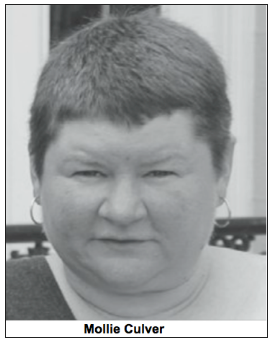
At the time of the hit-and-run outside EOS Lounge, near Haley Street, Ms. Culver was district director of Mrs. Capps’ Santa Barbara office and Mr. Morua’s immediate superior. Now, as his second voicemail indicates, within hours of crashing his vehicle after a high-speed chase involving a good Samaritan, she was about to make an effort to help him.
TRYING TO GET MR. MORUA OUT OF JAIL
As the evidence uncovered in this investigation shows, Ms. Culver was initially aided in her efforts to help Mr. Morua by George Eskin, a recently retired Santa Barbara County Superior Court judge whose wife, state Sen. Hannah-Beth Jackson, D-Santa Barbara, is an ally of Mrs. Capps. Immediately after the crash, Judge Eskin, who’d returned to the bench in the role of “assigned judge,” would help the accused drunken driver retain the services of an experienced local criminal attorney, Samuel K. Eaton Jr.
By Dec. 7, Ms. Culver would text or call Mr. Morua’s mother and fiancé with information on Mr. Eaton’s fee and tell Ms. Montoya that she would help “cover” Mr. Morua’s bail.
Then, over the next two days, Ms. Culver would go so far as to sign Mr. Morua’s name on forms from the U.S. Department of Veterans Affairs with the intent of releasing his medical records and getting him into a treatment facility for veterans in Los Angeles.
While there’s no evidence linking Judge Eskin or Mr. Eaton to that effort, those VA documents and other records obtained from the U.S. House of Representatives prove that between Dec. 7-10, 2013, Ms. Culver and staffers in Mrs. Capps’ Washington office went to great lengths to help Mr. Morua, who was paid through mid-day Dec. 10.
The very next day, the congresswoman did a complete about-face; effectively disowning her district representative.
That was the day Mallory was taken off life support. Almost immediately Mrs. Capps’ office put out a statement that Mr. Morua had been fired as early as Dec. 8. His private attorney, Mr. Eaton, withdrew on Dec. 13 and that same day, after initially signing his name on VA documents to get him into the treatment facility, Ms. Culver told the lead Santa Barbara Police Department detective on the case that Mr. Morua was not authorized to be at the Independent’s party the night of Dec. 5.
It was at that party where Mr. Morua reportedly drank six vodkas in the hours before he got into his vehicle with a reported blood alcohol content of .17 and struck Ms. Dies.
“Damage control,” is how William Canfield III, former senior staff counsel to the U.S. Senate Select Committee on Ethics, sees it. “My guess is that soon after they were apprised of the hit-and-run and the fact that Raymond had been drinking, Lois or her staff or both combined, made a concerted effort to try and extricate her, and the way they were going to do that was to get Raymond into a VA program. The way they were going to do that was to use her congressional staff to do things Raymond couldn’t do himself – the idea being to put him into a program. He’d be away for awhile. Maybe people would start to forget this, maybe. But they went into damage control.”
INTERVENTION FROM THE FORMER JUDGE
In the weeks leading up to his DUI arrest, Mr. Morua was heavily involved in a controversy over the future of the Veterans Memorial Building on Cabrillo Boulevard.
On Dec. 5, the morning before the hit-and-run, he exchanged emails with Judge Eskin and dined with him at the Independent’s Local Heroes luncheon. A former deputy district attorney in Ventura County, the 76-year-old judge had retired from the Santa Barbara Country Superior Court in October 2013 after 10 years on the bench, but the judge’s wife made for other close ties to Mr. Morua.
State Sen. Jackson appeared with Mr. Morua at multiple events over the last two years. In July 2013, she was co-presenter with him at the Latino Business Awards and in August they both attended an anti-DUI press conference. James Joyce, the senator’s deputy district director, was so close to Mr. Morua that they each spoke at a Veterans Day event last November, and the two aides spent time texting and talking issues at the Independent’s party in the hours before the collision. 
Judge Eskin was the impetus behind the formation of the local Veterans Treatment Court in August 2012, presiding over its first “graduating class” of five vets accused of various crimes, who were allowed to enter treatment rather than serving prison time.
According to Megan Behrens, the public defender assigned to the Veterans Treatment Court, one of the principal facilities for treatment court referrals was New Directions for Veterans, a complex of five treatment centers in Los Angeles with a staff of 14 and 2011 revenues topping $7 million.
New Directions is funded by federal grants and disability benefits paid by the Department of Veterans Affairs.
At 2:09 a.m. on Dec. 6, 2013, just hours after Mr. Morua’s arrest, Judge Eskin received an email from Ron Dexter, an active member of Veterans for Peace. Mr. Dexter, who had no idea at the time that Mr. Morua was under arrest, suggested to Judge Eskin that the three of them get together to discuss the Veterans Memorial Building issue. At 9:06 a.m., also apparently unaware of the arrest, the judge emailed him back that he would “make time because it’s very important to me.”
 But by 11:29 a.m., Judge Eskin was clearly aware of Mr. Morua’s situation. In fact he sent him an email that contained no message; only a subject line: “Sam Eaton (ASAP) 963-3014.” Mr. Eaton is a former U.S. Army officer and longtime friend of the judge. The two lawyers worked in the Los Angeles City Attorney’s Office at the same time in the 1970s, and in 2005, they spoke on a panel at UCSB together.
But by 11:29 a.m., Judge Eskin was clearly aware of Mr. Morua’s situation. In fact he sent him an email that contained no message; only a subject line: “Sam Eaton (ASAP) 963-3014.” Mr. Eaton is a former U.S. Army officer and longtime friend of the judge. The two lawyers worked in the Los Angeles City Attorney’s Office at the same time in the 1970s, and in 2005, they spoke on a panel at UCSB together.
In an interview for this series Mr. Dexter said, “There’s a history of George and Raymond. He was very impressed with Raymond and when this happened he was very upset, so he did what he could. He suggested that money be raised to hire Sam.”
But Mr. Eaton was not retained right away. The next day, Dec. 7 at 7:39 a.m., Teresa Montoya got a call from Deedra Edgar, a deputy public defender. At that point Ms. Edgar had not yet been formally assigned to Mr. Morua’s case, but she was on call and she reached out to Mr. Morua’s fiancé via the public defender’s emergency line.
Ms. Montoya spoke to her for 43 minutes.
Later that day, just before noon, Ms. Montoya says Mollie Culver picked her up to visit Mr. Morua, who was then in County Jail. His stepfather, Albert Canchola, rode in a separate car with his wife, Rose Saucedo, Mr. Morua’s mother. In a timeline of the events compiled by Ms. Montoya and Mrs. Saucedo, they write, “Mollie mentioned that she would have Raymond’s friend, the judge, send someone to help him.” 
Phone records indicate that Ms. Montoya had three phone conversations with Ms. Culver that day, including one at 4:27 p.m. She memorialized the conversations in a series of texts sent to Mrs. Saucedo’s cellphone. According to the text Ms. Montoya sent her at 5:49 p.m. “Sam Eaton” had been “recommended” by Mr. Morua’s “boss,” Mollie Culver.
At that point Mr. Morua’s family was in a quandary as to whether to stay with the public defender or hire Mr. Eaton, the private attorney. Further, if they did that, who would pay his fee, which Ms. Culver estimated, according to Ms. Montoya, to be $7,500 plus $1,000 for an investigation. That was in addition to Mr. Morua’s bail, which, at that point, could have been as high as $10,000 since his total bond was initially $100,000.
Ms. Montoya says Ms. Culver told her by phone that she would help with bail, but that the family needed to contribute as well.
By Dec. 9, a Monday, Mr. Eaton had taken the case and was going to appear with Mr. Morua at a hearing the following day in Santa Barbara County Superior Court. At 1:58 p.m. Ms. Montoya sent Mr. Morua’s mother a text confirming that, “Mollie got word from the lawyer Sam. He will be going today to meet Roc and so will Deedra,” the public defender.
“Roc,” short for “Rocky,” is the nickname for Mr. Morua used by his parents.
SIGNING DOCUMENTS FOR THE VA
On Dec. 9, 2013, Mollie Culver left this voice mail message for Mr. Morua’s mother: “Hi Rose, this is Mollie from Lois Capps’ Office. Can you please give me a quick call? 550-9300. I’ve got just two quick questions for you on this paperwork for the VA that we’re trying to get in right away. Thanks so much.”
The “paperwork” involved two separate official VA forms. The first, Form 10-5345, a “Request For And Authorization To Release Medical Records Or Health Information.” At 3:34 p.m., not long before Ms. Culver called Rose Saucedo, the evidence suggests that a copy of that form had been faxed to Santa Barbara from an office on Capitol Hill.
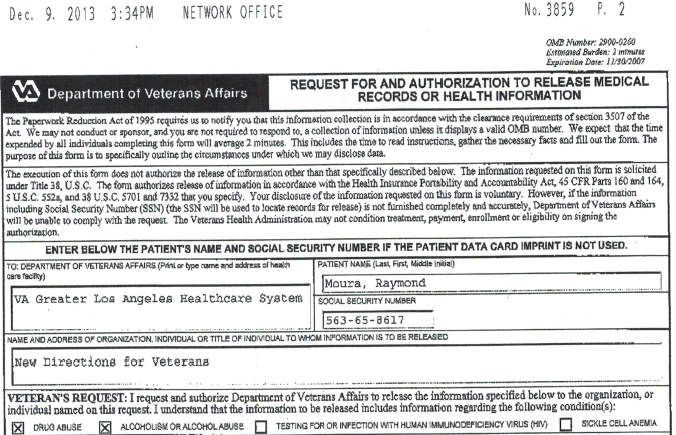 The form had been partially filled out in a Courier typeface, presumably by staffers in Mrs. Capps’ Washington, D.C., office. It requested that Mr. Morua’s records be released to New Directions for Veterans treatment facility in Los Angeles. In a box requiring a “Purpose or Need For Which The Information To Be Used” the partially filled-out form said “Exploring treatment options for Mr. Moura (sic) to address his addictions treatment needs.”
The form had been partially filled out in a Courier typeface, presumably by staffers in Mrs. Capps’ Washington, D.C., office. It requested that Mr. Morua’s records be released to New Directions for Veterans treatment facility in Los Angeles. In a box requiring a “Purpose or Need For Which The Information To Be Used” the partially filled-out form said “Exploring treatment options for Mr. Moura (sic) to address his addictions treatment needs.”
As the “Organization? To Whom Information Is To Be Released” the form listed “Office of Congresswoman Lois Capps 301 East Carrillo Ste. A Santa Barbara” with the office phone number. 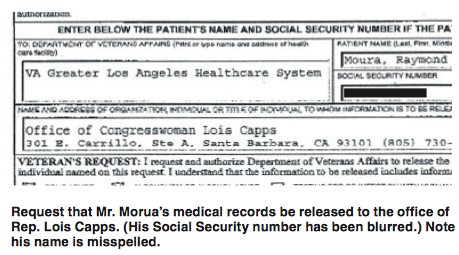
There was only one other requirement before the form could be sent in to the VA: Mr. Morua had to sign it. But that afternoon the form was filled in, not by the man accused of a DUI hit-and-run sitting in County Jail, but allegedly by Ms. Culver. In blue ink she allegedly signed Mr. Morua’s signature.
We know this because at the same time FORM 10-5345 was faxed from Washington, with Mr. Morua’s named misspelled “Moura,” a second FORM: 10-10 EZ “Application For Health Benefits” was faxed to Mrs. Capps’ office in Santa Barbara.
Ms. Culver signed Mr. Morua’s name on that form as well, along with other personal information including his Social Security number, date and city of birth, dates of military service and his home address; going so far as to list herself and her cellphone number in the box for Mr. Morua’s “Home Telephone.”
Using the same blue ink she’d used to sign Mr. Morua’s name twice on the first two-page form, Ms. Culver then listed his gross annual salary $36,000 and went so far as to write $200 in a box requesting the “Cash Amount In (Mr. Morua’s) Bank Account.” Ms. Culver then signed Mr. Morua’s name on that second form and dated it 12-9-13.
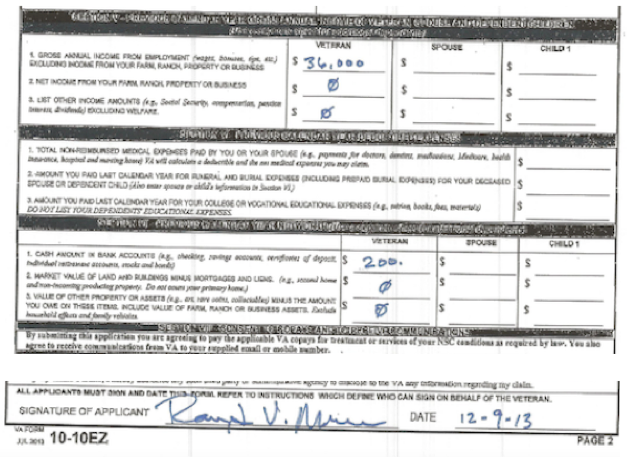 The top of that health benefits application says, “Federal law provides criminal penalties including a fine and/or imprisonment for up to 5 years for concealing a material fact or making a materially false statement.”
The top of that health benefits application says, “Federal law provides criminal penalties including a fine and/or imprisonment for up to 5 years for concealing a material fact or making a materially false statement.”
But Ms. Culver seemed to be in an urgent rush to fill out that form along with the Release of Medical Records form. At 1:28 p.m., she called Ms. Montoya and spoke to her for seven minutes. Ms. Montoya then texted the gist of their conversation to Mrs. Saucedo at 3:15 p.m.
“Mollie sent this: ‘I will know more on VA shortly. They are trying to get him emergency admittance to a wonderful in patient treatment that is specific for vets dealing with legal issues called new directions in la.'”
The fax number at the top of those forms, from a machine on Capitol Hill, confirms that they were sent to Mrs. Capps’ Santa Barbara office between 3:34 and 3:35 p.m. on Dec. 9.
The typeface, date, time, pagination and fax machine numbering sequence on that form is identical to the same identifying information at the top of a letter sent to Matthew Stoll, an attorney in the firm representing the Dies family, from Mary Beth Walker, the House lawyer representing Ms. Culver, Mrs. Capps and her staff on Dec. 23, 2013.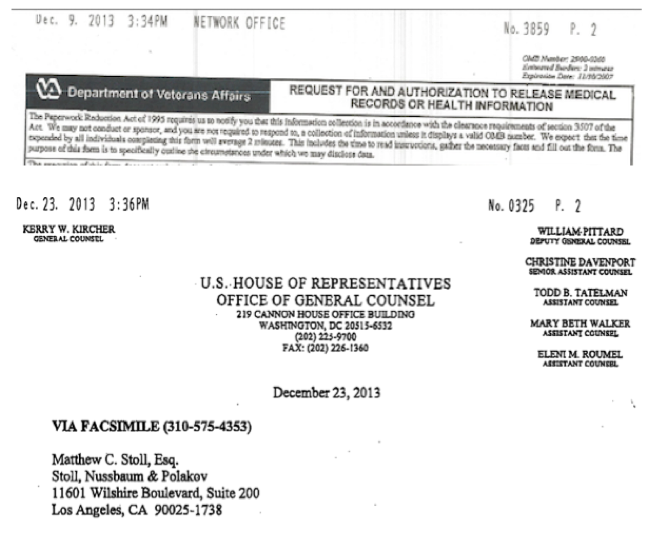
Ms. Montoya’s phone bill shows that Ms. Culver called her at 3:36 p.m. – one minute after she received those VA Forms.
“Mollie was desperate to get hold of Raymond’s mother so she could fill out those forms and get Raymond out of jail,” Ms. Montoya says.
“Around that time Mollie called me (and) said she needed personal information,” says Mrs. Saucedo. “I was in my car and she made it seem so urgent, I pulled over to talk to her. She wanted my son’s city of birth and my marriage name. We trusted her because, as his boss, we felt that she was trying to help Raymond. She was a government official and we believed that she knew what was best. We had no idea she’d (signed) his name or that any of this was (possibly) illegal.”
By now attorney Mr. Eaton had been hired to replace Mr. Morua’s public defender, Ms. Edgar.
In a follow-up text that afternoon, Ms. Culver told Ms. Montoya that both Mr. Eaton and Ms. Edgar would visit Mr. Morua in County Jail. “Mr. Eaton would not have come into this case but for George Eskin and Mollie Culver,” says Ms. Montoya.
REACTION FROM MOLLIE CULVER
When contacted by cellphone March 20 about the VA forms and other issues uncovered in this investigation, Mollie Culver said, “I can’t talk to you on advice of counsel” and hung up. A follow-up email to Ms. Culver included 13 questions including, “Was Cong. Capps aware, at any time, either prior to you filling out the aforementioned VA forms or after the fact, that you were seeking to get special treatment for Mr. Morua by getting him out of jail and into the New Directions facility with the assistance of the Department of Veterans Affairs?”
As of Tuesday, Ms. Culver had not responded. Neither had Rep. Capps, who was contacted directly via her website on March 20, nor had her press secretary, Chris Meagher, the former crime reporter for the Santa Barbara Independent who was present with Mr. Morua at the paper’s Holiday Bash and may have been a witness to him drinking alcohol at that event.
Multiple efforts were made to get a response from Judge Eskin, but he never responded. As noted, there’s no evidence that he was directly involved in Ms. Culver’s alleged effort to get Mr. Morua into New Directions, but when I contacted officials at the Los Angeles treatment facility to ask if anyone there was aware of that plan, Cindy Young, vice president of development and marketing, had this to say:
“There are many steps that would need to occur before a veteran could be court-ordered to New Directions. For starters, a court process involving a judge, public defender and district attorney would have to occur that would lead to a decision to make an alternative sentencing order for a particular veteran. New Directions has no power to bring a veteran into its program that would somehow sidestep this court process.”
“But at this point Mr. Morua was simply charged,” says attorney Darryl Genis, who took over as Mr. Morua’s counsel Jan. 15, after Mr. Eaton had withdrawn and Ms. Edgar resumed her representation of him.
“He was far from being sentenced; and while we can’t say for sure that Judge Eskin had a hand in this, New Directions was one of his veteran court’s go-to facilities. We know that Judge Eskin was the key to getting Sam Eaton involved, and according to what Ms. Culver was telling Raymond’s family, this judge who’d only stepped down from the bench in October, was interacting with her on Raymond’s behalf in the days right after his arrest.”
“What we do know for sure,” says Robert Stoll, another of the Dies family attorneys, “is that as late as three days after this horrific accident, the district director of Lois Capps’ office goes so far as to risk violating federal law to get him out of jail and out of town into a facility that would be partially funded by U.S. taxpayers. She’s also heavily involved in getting him private counsel. Now why would Lois Capps’ lead staffer in Santa Barbara go to those extremes if she believed that he wasn’t working in the course and furtherance of Mrs. Capps’ interests on the night of Dec. 5 prior to the accident? This was a bold scheme to protect a man, who was Mrs. Capps’ district field representative. A man clearly viewed at that point as an employee.”
THE FACE-TO-FACE MEETING
On Dec. 10, 2013, Mollie Culver called Teresa Montoya at 8:59 a.m. “She told me she had some things she wanted to talk about in person. Not on the phone.” Ms. Montoya says. “So she came over to the apartment building on De la Vina where Raymond and I lived. We sat on the front steps and she pulled out a file folder.”
That folder contained Sam Eaton’s email address and phone number. Inside was the second VA form that Ms. Culver had filled out, the application for benefits. There was also a page of yellow legal paper on which Ms. Culver had written: Craig Lea VA Desert Pacific Network (22) 562-826-8000 X 4323 craig.lea@va.org
“Mollie told me that she had already sent in the form to the VA for the release of medical records, but in order to complete the process of getting him into New Directions, I would have to fax the other form to this man, Craig Lea, at the VA.”
Ms. Montoya says she asked Ms. Culver why she had to meet her in person to tell her this and Ms. Culver told her that, “our office may no longer be able to intervene for Raymond directly.”
“I asked her why not,” Ms. Montoya says, “and she told me, ‘We have inside information that they’re going to take Mallory off life support in the next 12-24 hours and if that happens, we can’t be involved.'”
At that point Ms. Montoya says, Ms. Culver instructed her to fax in the second form to Mr. Lea. “When I saw that it wasn’t Raymond’s signature on the form, I questioned that but she said, ‘We couldn’t get it because he’s in jail, but if you get this to Craig (Lea) right away we can get him into this facility in L.A. But you have to do it today.’ She also told me she had lots of examples of Raymond’s signature in the office as a reference.”
 “The impression I got from her,” says Ms. Montoya, “was that things could change radically if Mallory passed away. So later that day, I made a pdf of the form (10-10EZ) and emailed it to Mr. Lea. I got a confirmation that he received it.”
“The impression I got from her,” says Ms. Montoya, “was that things could change radically if Mallory passed away. So later that day, I made a pdf of the form (10-10EZ) and emailed it to Mr. Lea. I got a confirmation that he received it.”
THE 180-DEGREE TURN
At 9 a.m. the next day, Ms. Montoya got a puzzling email from Sam Eaton, who was still representing her fiancé: “RE: Case: Raymond Morua ? So, as we have heard, the young woman was declared brain dead and taken off life support,” he wrote. “This creates a very different situation where any ability to affect the outcome is now very limited. The charges will be either 2nd degree murder, 15 years to life; or PC 191.5, vehicular manslaughter, with 2 DUI priors, which is also 15 to life, to which they can add more time (5 years +) for the hit and run. Murder provides no good time/work time credit reduction, and tho manslaughter charge is to 15% credits.
“I have told George Eskin and Molly Culver that I don’t feel that I should continue with the case. The fees would be substantially increased with no reasonable probability of affection the outcome. I think Raymond should apply for the Public defender.”
At 12:09 p.m., Mr. Eaton sent a second email to Ms. Montoya: “I am pleased to have been of assistance. I am very saddened by this news as well. Raymond seems a worthwhile person with a lot to offer. I would only feel worse if I knew I was taking your family’s finances with no real possibility of doing anything meaningful about the charges.”
What is so curious about those two emails from Mr. Eaton, signaling his withdrawal, is that Ms. Dies was not declared brain dead and taken off life support until 3:15 p.m. that day, more than six hours after Mr. Eaton’s first email stating that “we have heard” that she passed away.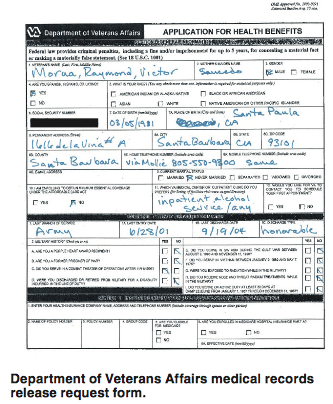
DISOWNING RAYMOND MORUA
In the hours after the death of Mallory Dies, the Capps office took immediate steps to disassociate itself from Raymond Morua. First they put out the word that he’d been fired on Dec. 8, two days after the hit-and-run. But records from the House of Representatives show him on the payroll at least through Dec. 10, around the time Ms. Culver asked Ms. Montoya to that in-person meeting.
Later Mrs. Capps’ Chief of Staff Sarah Rubenfield claimed Mr. Morua attended the party “of his own volition;” a position endorsed by House counsel Mary Beth Walker on Dec. 23.
By the morning of Dec. 13, 2013, a Friday, Mr. Eaton had formally withdrawn as private counsel. Rose Saucedo, Mr. Morua’s mother, says that though the family had raised “about $4,000 in cash” to pay Mr. Eaton, he never accepted their money. At that point Deputy Public Defender Deedra Edgar resumed her representation of the accused hit-and-run killer. She was later replaced by Mr. Genis.
Meanwhile, just hours after Mr. Eaton’s withdrawal, Detective Jaycee Hunter of the Santa Barbara Police Department served a search warrant on Mrs. Capps’ Santa Barbara office. After executing the warrant at 11 a.m., Detective Hunter interviewed Ms. Culver, who only days before had tried to help Mr. Morua.
She now claimed that he had not been representing Mrs. Capps at the Independent’s Holiday Bash, and that he may have actually taken the invitation off a desk in the district office.
Ms. Culver also told Detective Hunter that, “The office was unaware of the suspect’s criminal past of prior DUI arrests, a prior hit-and-run and theft from Kmart.” (In 2006, Mr. Morua was charged with DUIs in July and October and leaving the scene of a crash in December after he broadsided a woman’s car in Ventura. After the Kmart incident, he was convicted of grand theft embezzlement and served 10 days in jail in 2011 while he was working as an intern for Mrs. Capps.)
Six days after that interview with Detective Hunter, Ms. Culver appeared to do another about-face in a series of texts she sent to Mr. Morua’s fiancé, Teresa Montoya.
“This is really upsetting us all so much!!!” she texted Dec. 19. “pls tell raymond?we love him and we’ll still be there when this is over.”
Detective Hunter’s narrative of the search warrant execution and his interview with Ms. Culver makes no mention of finding any of the VA forms on which Ms. Culver signed Mr. Morua’s name. According to his narrative, the search seems to have been limited to “the suspect’s desk” where Detective Hunter confiscated some photographs, including one reportedly showing Mr. Morua with “a male associate ? holding, what appears to be glasses of beer (and) smiling for the camera.”
“It defies belief,” says Mr. Morua’s attorney, Mr. Genis, “that Capps’ district director would risk breaking federal law to get him out of Dodge and into treatment if he wasn’t working for them. The only difference between when Mollie Culver forged those forms and her utter denouncement of him to the SBPD was the death of Mallory Rae Dies.”
JUDGE ESKIN’S APPARENT TURNAROUND
On Dec. 15, nine days after intervening to help Mr. Morua retain attorney Sam Eaton, Judge Eskin also appeared to be distancing himself from the decorated Army veteran he’d been so close to in the days leading up to the arrest.
Both Mr. Morua and his fiancé had been part of an email list with Judge Eskin that included 13 other key players in the debate over the future of the Veterans Memorial Building on Cabrillo Boulevard; a controversy that resulted in Mr. Morua being cited in an article in the Independent on the very morning of the paper’s Holiday Bash.
At 6:55 a.m. on Dec. 15, Ellery Price, commander of the local chapter of Disabled American Veterans, forwarded an email to the members on that list from Atty P. Garfinkel, a friend of Mr. Morua’s, who wrote, “It is my belief that Raymond drinks as a reaction to possible psychological factors resulting from his time serving our country in the armed forces.”
Judge Eskin’s response: “Please delete me from this distribution list.”
Shortly thereafter, Judge Eskin returned to active duty as a Superior Court judge and on Dec. 19, 2013, after Ms. Montoya emailed to thank him for “helping Mollie to find Mr. Eaton” she asked if he was “interested in visiting with” Mr. Morua. This was Judge Eskin’s reply:
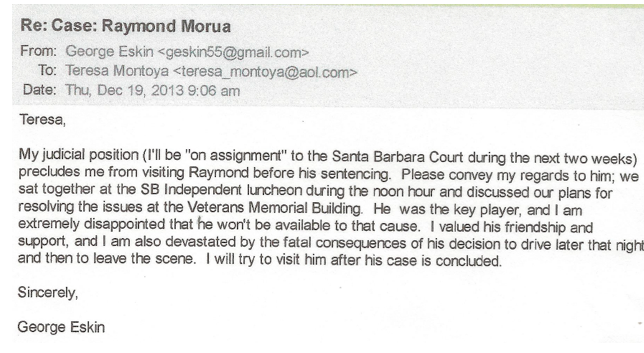 According to Teresa Ruano, spokeswoman for the California Judicial Council, “Judge Eskin took his oath for the Assigned Judges Program on Dec. 2.”
According to Teresa Ruano, spokeswoman for the California Judicial Council, “Judge Eskin took his oath for the Assigned Judges Program on Dec. 2.”
That was four days before he referred Mr. Morua, then in jail, to Mr. Eaton.
“He has had several assignments in the program,” she said. “The first was in Santa Barbara beginning on Dec. 23 and ending Jan. 3. Since that time, there have been several additional assignments, in Santa Barbara, Ventura and San Luis Obispo Superior Courts.”
Ms. Ruano says “Judges who participate in the Assigned Judges Program” are held to the same rules in the Code of Judicial Ethics as permanently sitting judges. While there is no specific prohibition precluding a judge from referring a personal friend to legal counsel, several canons of the code mandate that “a judge shall avoid impropriety and the appearance of impropriety in all of the judge’s activities.
email: pl@peterlance.com




Recent Comments